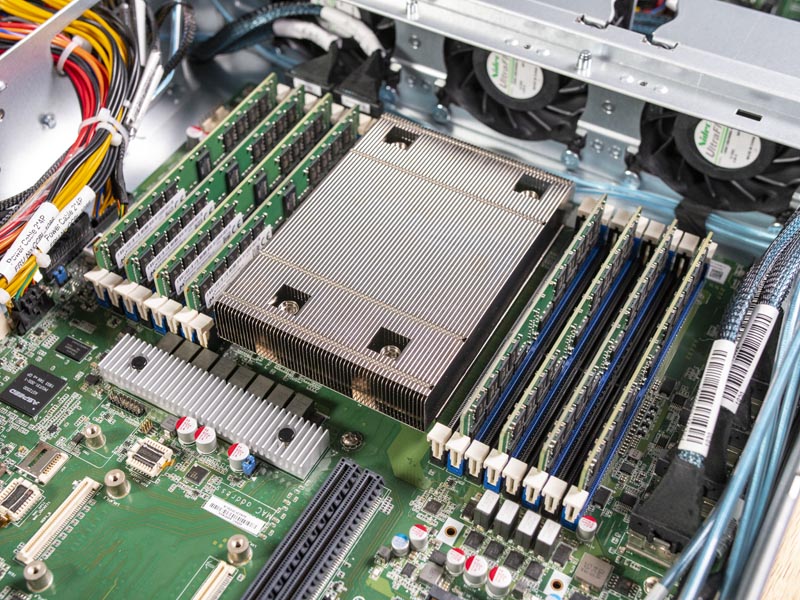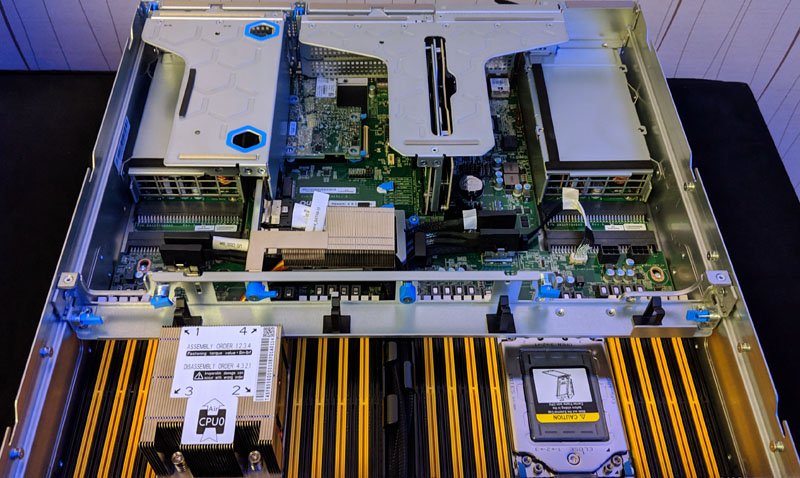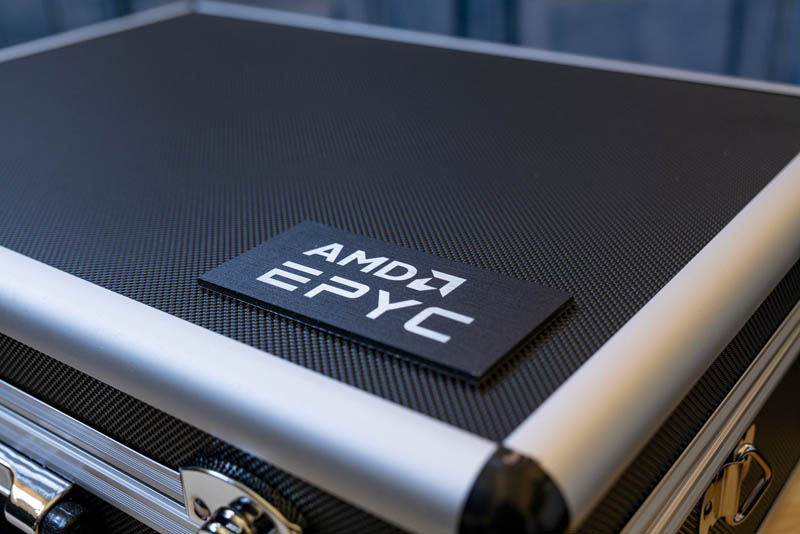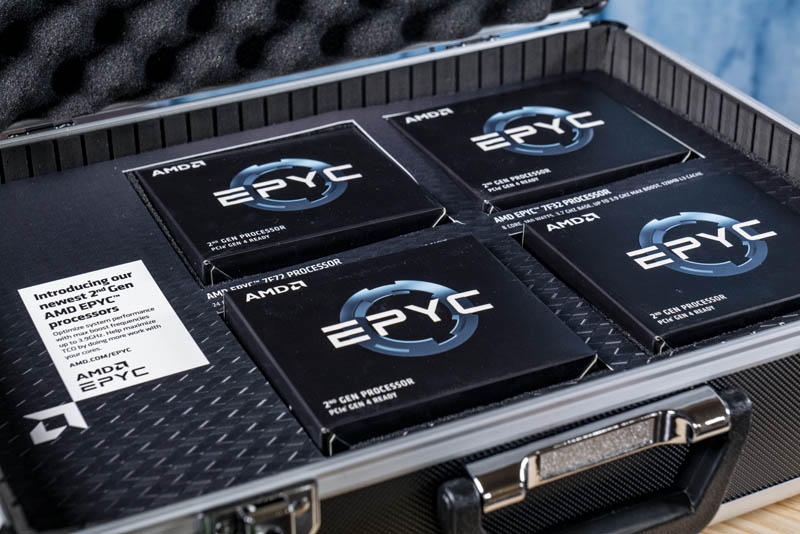AMD EPYC 7F72 Test Configurations
For our testing, we utilized both single and dual-socket configurations to show different aspects of performance, check the 1P story, and gain access to both of our comparison sets.
Test Configuration: Single Socket
For most of our charts, we are using the Tyan Transport SX TS65A-B8036.
- Platform: Tyan Transport SX TS65A-B8036
- CPU: AMD EPYC 7F72
- RAM: 8x 32GB Micron DDR4-3200 RDIMMs
- OS SSD: 400GB Intel DC S3700
- Data SSD: 960GB Intel Optane 905P
You are going to see more about this platform, but this is a PCIe Gen4 single-socket platform from Tyan that has 16x front U.2 NVMe bays, 10x front SATA/ SAS bays, two rear 2.5″ SATA OS SSD bays, six expansion slots on risers and an OCP mezzanine slot. All this is achieved using a single AMD EPYC 7002 series CPU.

Some servers are not going to be designed to accept such high-power CPUs so one needs to watch out for those when shopping for servers. On the single-socket side, it is less of a concern. In form factors such as 2U 4-node, it will be a bigger concern.
Just to note, the topology picture above was using this server to show a single CPU to keep things simple.
Test Configuration: Dual Socket
We also had a test configuration for dual-socket processors. We have been using the AMD “Daytona” reference platform and we had the latest AGESA for this as well.
- Platform: AMD “Daytona” Reference Platform
- CPUs: 2x AMD EPYC 7F72
- RAM: 16x 32GB Micron DDR4-3200 RDIMMs
- OS SSD: 400GB Intel DC S3700
- Data SSD: 960GB Intel Optane 905P

Note, this platform looks a lot like the Quanta AMD EPYC Rome Servers Set to Make a Splash that we covered on a Q4 2019 visit to Taipei, Taiwan.
How the Processors Arrived
Typically, when we get processors we consider ourselves lucky to get a tray with chips. For this launch, AMD went the extra mile and we received the chips in a hard case.

Opening the case we found the two EPYC 7F72 and two EPYC 7F32 CPUs and a little bit of marketing spin.

This was a fun treat that is common on the consumer hardware review side but very uncommon in the realm of servers. Frankly, this is something that we do not want to get with every release. 25-50 hard cases a year would be too much. At the same time, this presentation was awesome to unbox even if it is not going to be the typical customer experience.
Next, let us get to performance before moving on to our market analysis section.




I know STH dont normally write anything on stocks and quarterly reports. But I do wish STH write a pieces that suggest why EPYC is doing as good as most of us expected it to be. It has yet to break the 10% shipment barrier, all while Intel is making record quarter YoY in DC and HPC. That is all in the time when Intel 14nm is operating at full capacity and one node behind.
Most have been suggesting these things takes time, but it is already a year of Zen 2 and shows no signs of improvement.
Can we have the single threaded results for the UnixBench Dhrystone 2 and Whetstone Benchmarks on a separate axis or chat?
For a part that is specifically targeting better single threaded performance, it would be nice to have a little more focus on that aspect. A lot of problem domains enjoy multi-threaded environments, there are still others which focus on raw single threaded performance. A comparison here to Intel’s similar offerings would be very beneficial.
A great article as usual and I very much enjoy reading STH content, hopefully the feedback will be helpful. Thanks
@Stephen,
Given that this and the rest of the CPUs are intended for use in server system, why would single threaded performance matter?
Servers are purchased/justified on the basis that they provide resources for a number of tasks, so they are never running “one thing”. Further, single threaded processes would not be representative of real usage, since each CPU has there own inherent trade offs — higher base clocks vs. more cores/threads vs. TDP.
wow this is beast wondering how it will feel like setting this 24 core cpu as gaming pc by adding rtx 280 gpu along it.
Again an irrelevant review of a core frequency optimized part.
All your benchmarks shows that more cores are better than fewer but frequency optimized cores.
I sound like a broken record player repeating the same request over and over….
Please add variations of the benchmarks where there are 4 – 8 threads active!
That will show what these parts are made for and will also show the value of turbo modes, high TDP.
It may also show the only remaining performance reason to pick Intel in 2020.
@BinkyTo,
Latency sensitive applications care about single-threaded performance. We run multiple processes per server, there is of course a trade off between singled-threaded performance and number of cores available that we have to make. However doubling the number of cores while taking 20% off the clock speed is going to make us go slower, not faster.
Details about turbo modes, all-core and subset core would also be very interesting and information is often difficult to find.
@zack – it would feel expensive.
As a frequency part, should not there be more database related benchmarks?
This processor is for use with Oracle or SQL Server, too. THAT is what datacenter servers do. In those scenarios, doubling cores while dropping GHz could-very-well be a WIN.